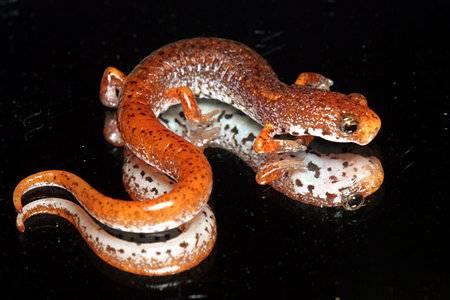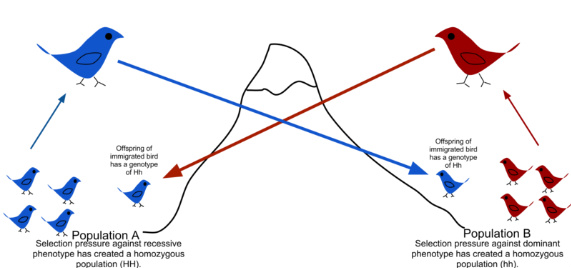It’s an early autumn evening somewhere in eastern North America. A cool breeze rustles the dead leaves on the forest floor. Somewhere among the twigs and fallen logs, a male four-toed salamander is on the prowl. His quarry, however, is not some crawling invertebrate destined to be his dinner, but a female of his species. Using his keen chemical sensing (or vomeronasal organ) to follow the trail of chemicals and pheromones she has left behind, he suddenly comes upon her. In appearance, she is like himself: roughly two inches long, with a black-on-white Dalmatian spotted belly and a beige-bordering-on-orange back. Because she has no outer features to indicate her gender, the male uses his vomeronasal organ to tell that yes, this is the female he has been looking for.

Having tracked down this lovely member of the opposite sex, the male approaches her and makes contact. He caresses her cheek with his head, transferring chemical information between the two of them and letting her know his intentions. Continuing the first overtures of courtship, the male crawls beneath her chin while maintaining constant contact between his back and the undersurface of her chin. When the base of his tail reaches her chin, his back arches and his tail begins to snake back and forth, enticing her to accept him as a mate. He moves forward, hoping that she’ll move will him, maintain the chin-back connection between their bodies, and enter into the courtship dance with him. Tonight, however, is not his night. Instead of following the male’s lead, she breaks off the engagement and moves away, leaving him with his ambitions unfulfilled.
What happened? Where did this desperate male go wrong? To the eye, he appears to be a perfectly healthy male, an excellent example of his gender, and all that any female could want. His chemical signature, however, may be telling the female that he’s not the one for her, that by mating with him she may be risking unhealthy offspring in the short-term, and in the long-term may contribute to the decline of her species. How can this be?
Salamanders are an important part of the ecosystems where they live, but like many amphibians, they are also frequently found on the endangered species list. Why is this? One culprit could be inbreeding. When populations decrease in size, the number of potential mates dwindles as well, and salamanders may be forced to mate with relatives. Unfortunately, this inbreeding leads to a decrease in the types of genes present in a population, and may result in inbreeding depression if the offspring produced are less healthy and weaker than their parents. For example, in Florida, panther populations declined to the point where all remaining panthers were closely related to each other, and all mating attempts were, therefore, results from inbreeding. Researchers noticed that the panther populations continued to lose ground, and these inbreeding unions resulted in fewer and less healthy offspring. To save the Florida panther, researchers imported panthers from other populations in the United States, increasing the types of genes available in a population and providing unrelated mating partners. Their efforts succeeded and the health of the Florida panther populations immediately improved. Inbreeding, therefore, may increase the rate at which the population is decreasing in size. How are organisms usually able to prevent inbreeding depression? The answer is a process called gene flow.

Gene flow occurs when organisms move between populations, taking with them the different types of genes that each one possesses. Like a foreign exchange program for genes, this causes “foreign” types of genes to come into a population while sending familiar types of genes out to other populations. This exchange keeps the diversity of genes in a population high and prevents the population from becoming a closed group of related individuals. Gene flow can be impacted by natural barriers like rivers or mountains, or by man-made barriers like agricultural fields, subdivisions, and roads.
Which brings us back to our choosy, female, four-toed salamander. Four-toed salamanders are small and possess a moist, permeable skin leaving them vulnerable to drying out and desiccation. As a result, they are probably not very good at moving long distances, and so even in the best of conditions may have trouble keeping high levels of gene flow. How are these salamanders able to avoid inbreeding depression? Some scientists believe that the female salamander may be able to recognize closely related males by examining his chemical and pheromonal signal by using her. As a result, female salamanders may be able to prevent inbreeding simply by being picky and avoiding closely related males.
Turning down a chance to mate can be risky, though. What if the female doesn’t find a better male? In many salamander species, a female may mate with several males. And because she is able to store the sperm within her body without yet fertilizing her eggs, she can “choose” at a later time which sperm to use and then discard the losers. Thus, while males can never be certain that they have successfully fathered offspring, these picky females are able to ensure that they have the healthiest offspring they can have. So for salamanders, dating may not just be about the romance, it may be about preserving the health of the next generation and the species as a whole.
Written by Abigail J.M. Berkey, Ph.D. candidate in Ecology, Evolution, and Conservation Biology.
Feature image from tolweb.org.
~~*~~
Smile Politely is proud to introduce a new running series we are calling “Science Politely” that will feature the work of graduate students at the University of Illinois throughout November and December. Working in collaboration with the students in a graduate course in Integrative Biology, Science Politely is a collaboration aimed at bridging the gap between town and university, between scientist and citizen, and between research and culture.








